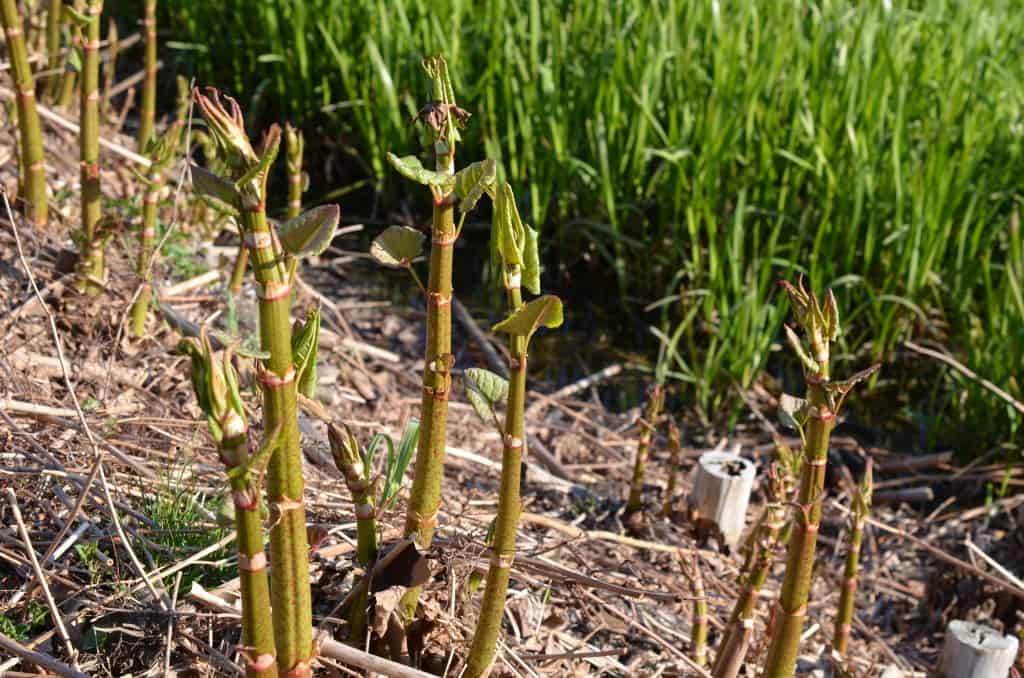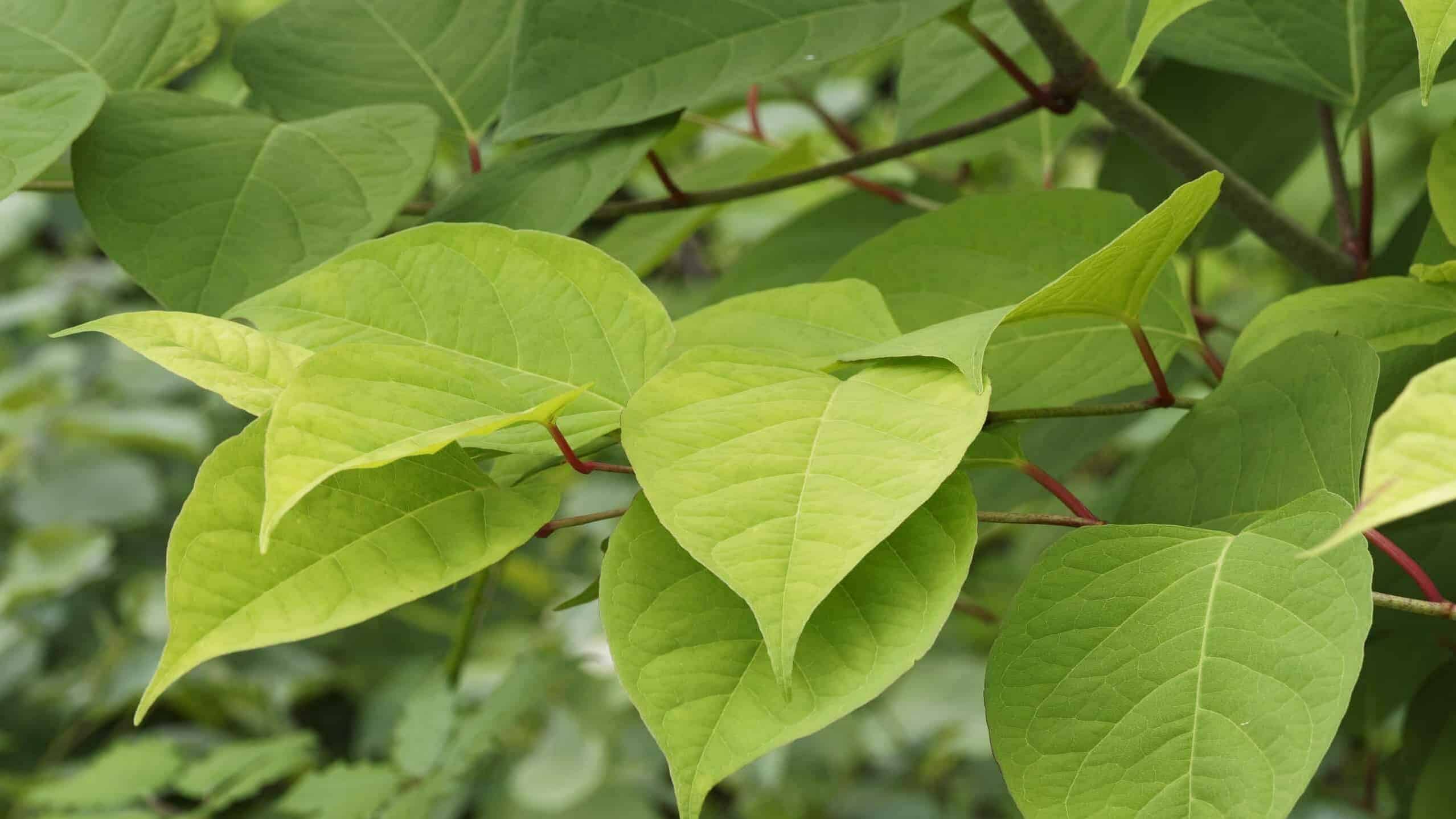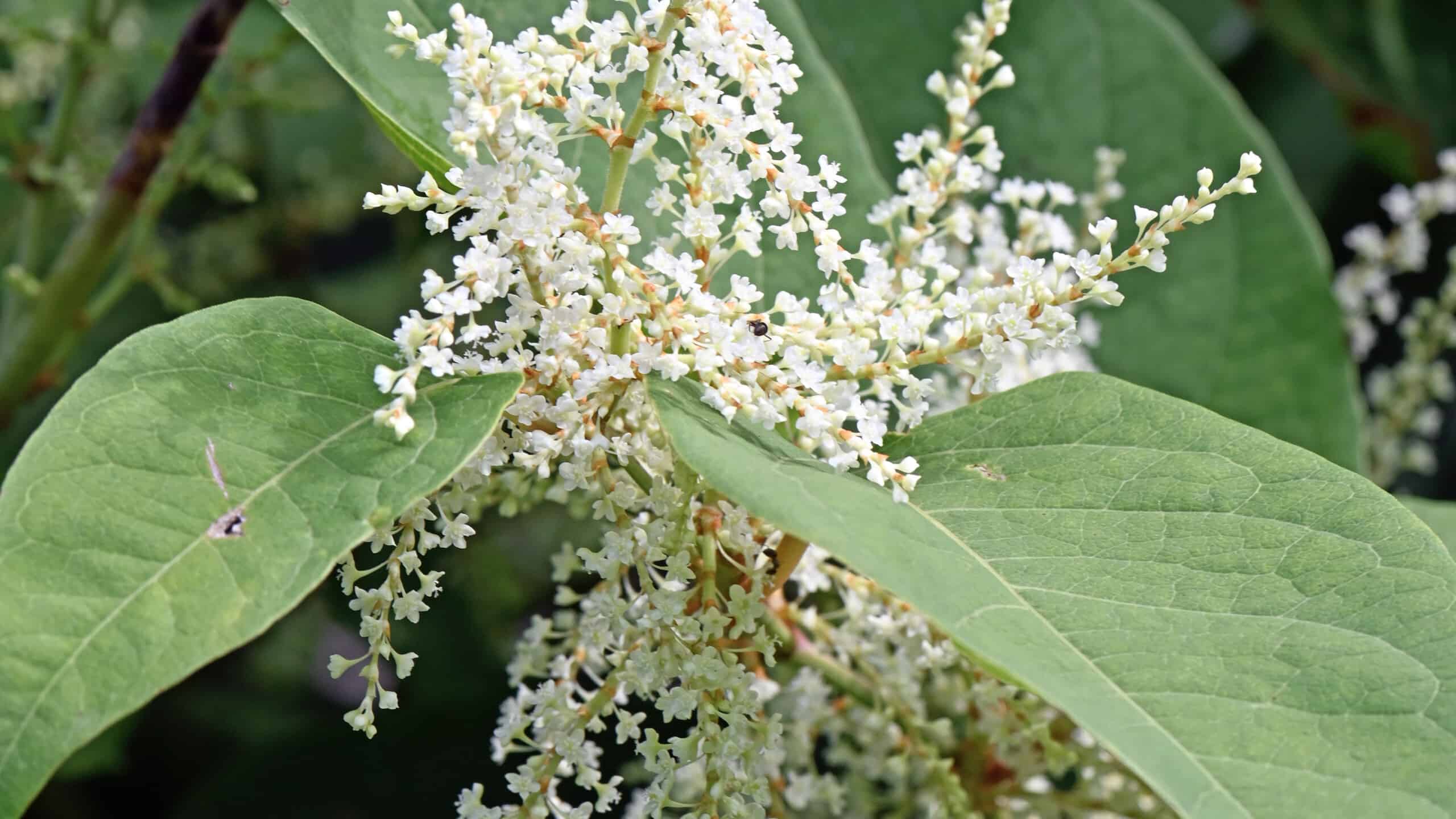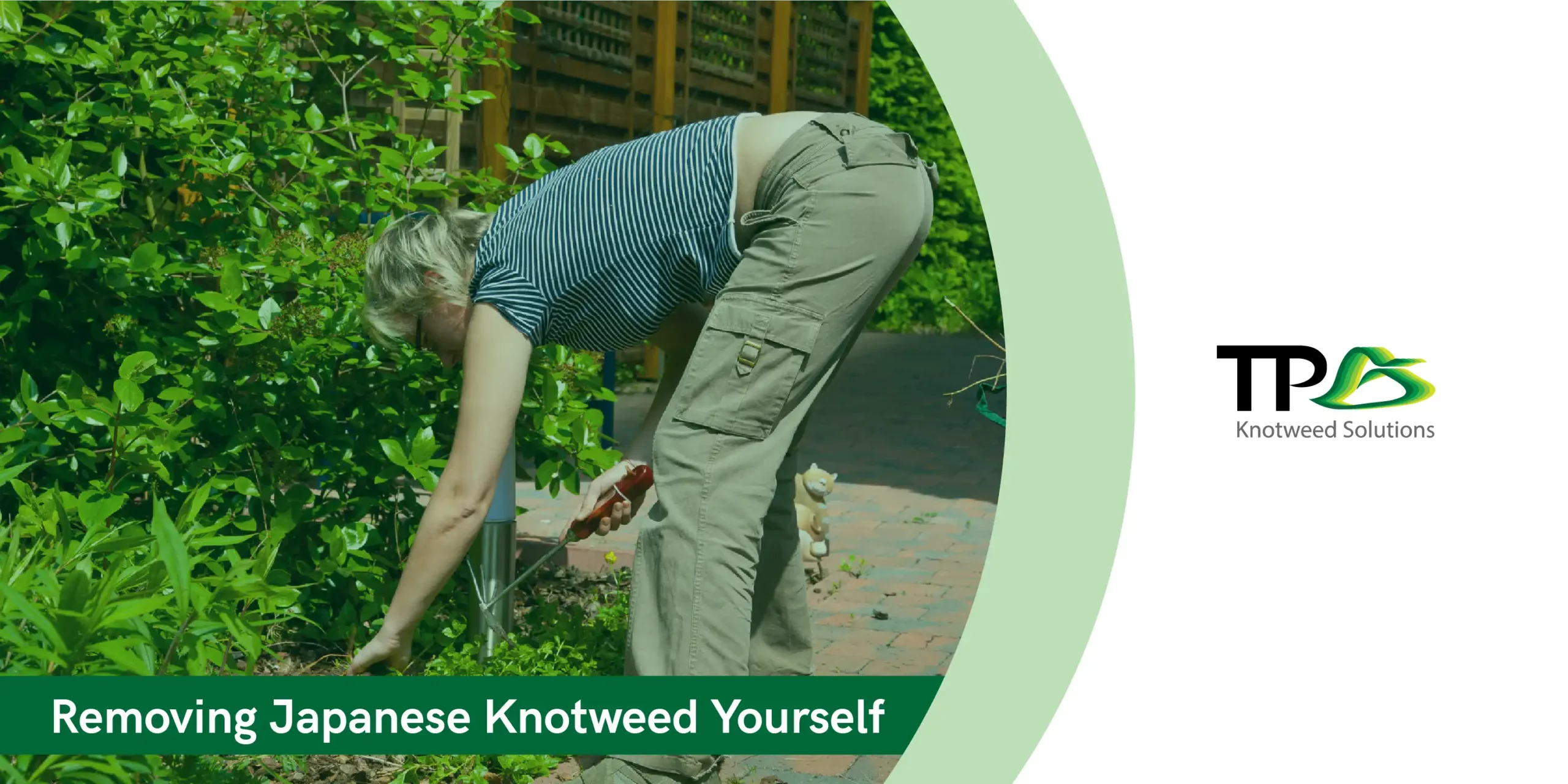In this article we will walk you through 10 of the most interesting Japanese knotweed facts. Have you ever wondered how these non-native weeds came to thrive in the UK? Or felt confused or anxious about your legal responsibility in regard to the plant? Perhaps you’d like to find out if you can treat the knotweed yourself? Or are you more interested in its cost to the economy? Read on to have your questions answered. If your questions remain unanswered, please do not hesitate to contact one of our team who will be very happy to assist you.
- How was it introduced in the UK?
- Listed as one of the world’s top 100 worst invasive species
- Are there any natural enemies that can be used to help prevent its growth?
- Estimated annual costs to the British economy
- Growth capabilities and main characteristics throughout the seasons
- Infestation ratio and legal responsibility
- Controlled disposal is necessary
- A glimpse into the existing laws about the Japanese knotweed plant
- It can take several years to remove
- London 2012 Olympics and Japanese knotweed infestation problems
How was Japanese knotweed introduced in the UK?

Japanese knotweed (also known as Fallopia japonica) is a native of Japan and was first imported to the UK during the Victorian period as an ornamental garden plant. Japanese knotweed in the UK dates back to 1850 when a German-born botanist, Philipp Franz Balthasar von Siebold, brought it over to Victorian Britain. The plant proved popular amongst fashionable Victorian social circles, and as such it wasn’t long before it was being sold in mass from garden centres. During this time the spread of Japanese knotweed was largely intentional, but it also became apparent that Japanese knotweed could spread unintentionally.
Today we know that Japanese knotweed is a highly invasive, fast-growing weed which can grow at rates of up to of 10cm a day. It is a very strong plant; this characteristic has helped to ensure its survival and spread over the last century. Over time the UK has seen a massive spread in the prevalence of Japanese knotweed, to the point where almost nowhere in the UK remains knotweed free.
Along with this, we have become aware that its disadvantages outweigh its advantages. While the invasive weed may look attractive, and certainly the Victorians thought it was it, it is its ability to spread and cause extensive structural damage to driveways, roads and property foundations which has really caused problems. So much so that Japanese knotweed was added to the invasive species list and controlled under the Wildlife and Countryside Act 1981. It was later legislated further under the Environmental Protection Act 1990 to try and control the spread and prevalence of Japanese knotweed.
Listed as one of the world’s top 100 worst invasive species
Japanese knotweed has become defined as an ‘invasive species’. An invasive species is any non-native life form that causes harm economically or to its physical surroundings. Japanese knotweed falls into this category due to the negative impact that it has on other plant species and infrastructure. It is no surprise, therefore, that the IUCN (International Union for the Conservation of Nature) named it as one of the top 100 worst invasive species.
Are there any natural enemies that can be used to help prevent its growth?
Although it is not a legal requirement to treat any knotweed on your land we strongly recommend that you instruct a licensed professional as soon as possible. If knotweed is left untreated you risk the infestation spreading and causing damage to your property or neighbouring land and properties, of which you would be liable for.
If you decide to treat the knotweed yourself there are some DIY remedies which might have some limited success. knotweed is well known for being a hardy plant which can take several years to be removed, even when using licensed herbicides. This is important to bear in mind; any treatment you implement will need to be repeated year on year to have any chance of removing the knotweed.
You might decide to try and treat the Japanese knotweed using a shop bought herbicide. If you do this, is you would be best to treat the infestation twice over the growing season and carefully follow the product label. Incorrect herbicide selection and use can be counterproductive and actually stunt the plants, making it very hard to kill the Japanese knotweed.
Alternatively, you might decide to dig the knotweed out completely to prevent the need to repeat twice yearly treatments. It Is important to bear in mind the structure of the plant, above and below ground, when undertaking this. It is very easy to spread Japanese knotweed when digging it out if you aren’t fully aware of the properties of the plant and its rhizome system. We know that Japanese knotweed has an extensive underground rhizome network which far surpasses the scale of the above ground plant, and if it is disturbed even a very small fragment of rhizome can be responsible for the plant’s spread. While digging the knotweed out it is likely that a small amount of rhizome will remain in the area which could lead to regrowth or spread.
We have heard of people using diesel or vinegar to treat Japanese knotweed. We have no evidence to suggest that this treatment would be successful and as such we strongly discourage you from doing this. It may burn the leaves or stunt the plant’s growth, but it will not kill it. It will also harm the environment.
So, while there are DIY Japanese knotweed removal methods available we do not recommend them. Japanese knotweed usually takes a number of years to fully remove and there are strict laws of disposal surrounding Japanese knotweed. Japanese knotweed can re-grow from cuttings as small as 2mm, meaning the smallest traces can lead to new growth. Because of this, knotweed is classed as controlled waste and must be disposed of safely at a licensed landfill site according to the Environmental Protection Act (Duty of Care) Regulations 1990.
Additionally, Mortgage lenders often require a formal Japanese knotweed removal plan and Insurance Backed Guarantee from a professional contractor in order to satisfy mortgage requirements.
Home removal methods will also mean that you do not have an Insurance Backed Guarantee, which can also be a requirement in order for buyers to obtain a mortgage for your property, or you will not be protected in the event of future regrowth.
In relation to the TA6 Property Information Form, you need to declare if you have Japanese knotweed present at your property when selling. The seller will then be required to provide evidence of a professional treatment programme, implemented by an accredited Japanese knotweed specialist and a 10 year Insurance Backed Guarantee.
Estimated annual costs to the British economy
Japanese knotweed’s destructive nature can result in costly damage to buildings and garden structures as well as preventing progress on projects and hindering house sales. Its ability to exploit existing weaknesses in properties as well as underground systems, walls and building foundations mean repair work can range into the thousands. With its advanced root network, the rhizomes grow through any structure which can make it more difficult to secure a mortgage against a property which in turn affects the property’s value.
Considering all this, it is easy to see why legislation was passed to control the spread of Japanese knotweed. Despite legal responsibility being in place for an individual or organisation to control the spread of knotweed it remains a fast growing and costly threat to the British economy.
The true financial cost of Japanese is difficult to fully measure. Depending upon the source, estimates range from between £41 million to £170 million a year in treatment, removal, project delays and essential repairs to infrastructure.
Growth capabilities and main characteristics throughout the seasons

Japanese knotweed can easily be confused with other similar plants at first glance, such as Himalayan knotweed and Bindweed. It is important to consider the characteristics of Japanese knotweed to correctly identify the plant as it is a highly invasive, fast-growing weed which can grow at speeds of 10cm a day. It’s aggressive growing ability can lead to costly damage to property and infrastructure.
Japanese knotweed is more easily identifiable in Spring when red buds emerge into new shoots. Japanese knotweed shoots take the form of reddish-purple shoots sprouting from the ground.
Left untreated, these will rapidly grow into the distinctive knotweed canes, but at this early point they are easily confused with the vegetable rhubarb.
These shoots grow rapidly at speeds of up to 10cm a day. Early growth leaves are red or light green in colour. Japanese knotweed leaves are shovel, or heart, shaped and have a spear-like tip.
Japanese knotweed is fully grown in the summer, the canes are matured and hollow and hold a distinctive purple speckle. They can grow up to three or four metres high. In late summer, and throughout Autumn, the Japanese knotweed flowers create clusters of small creamy-white flowers. Japanese knotweed roots or rhizomes are the extensive underground part of the plant. The rhizome is bright orange or yellow. The nodes are usually spaced approximately one or two centimetres apart.
By late Autumn the Japanese knotweed’s flowers drop. Their leaves start to turn yellow, before turning brown and eventually falling off. At this stage the Japanese knotweed identification can become more difficult. However, during winter months Japanese knotweed can still be identified by their hollow, brown brittle canes.
Infestation ratio and legal responsibility
Japanese knotweed has become a widespread problem in the UK. Due to the nature and ease of its spread there are very few areas of the country that remain untouched by Japanese knotweed.
There are two primary laws in place to regulate the spread of Japanese knotweed. The Environmental Protection Act of 1990 is the principal knotweed legislation that has been supplemented by a series if new regulations. The Wildlife and Countryside Act is another piece of legislation that controls the disposal of Japanese knotweed. The private and public sector are both required to comply with these statutes.
Briefly explained, In the 1990 Environmental Protection Act (EPA), Japanese knotweed is identified as a controlled substance. This act sets forth certain terms that regulate how Japanese knotweed can be disposed of. The act stipulates that Japanese knotweed can only be disposed of at landfills that are licensed to handle contaminated soil. The individual or organisation that has collected the knotweed is responsible for identifying a licensed landfill and transporting the knotweed to the licensed handler.
The Wildlife and Countryside Act seeks to protect native species and to regulate the spread of non-native plants and animals in the UK. Under terms of this act, the planting of Japanese knotweed is a crime and punishable by rather serious penalties including severe fines.
Controlled disposal is necessary
Due to Japanese knotweed’s invasive and fast-growing nature it was made subject to legalisation in 1990. This legislation defined Japanese knotweed as “controlled waste” under the Environmental Protection Act 1990. This means that Japanese knotweed must only be disposed of into licensed landfill sites to stop further spread. Any attempts to remove the knotweed plant should therefore be carried out by licensed professionals.
It is not illegal to have Japanese knotweed on your property or land, and you are not legally required to report the Japanese knotweed to any authority or neighbour. As such there is no legal obligation for you to treat or remove the knotweed on your land but you are legally responsible for ensuring that it doesn’t spread to neighbouring land. You are legally responsible for containing the Japanese knotweed to your land.
A glimpse into the existing laws about the Japanese knotweed plant
It is not illegal to have Japanese knotweed on your property or land, and you are not legally required to report the Japanese knotweed to any authority or neighbour. Your Japanese knotweed legal obligation is only to ensure that it doesn’t spread to neighbouring land. You are legally responsible for containing the Japanese knotweed to your land. If you do decide to treat the Japanese knotweed bear in mind that it can sprout from as little as 2mm of rhizome, meaning it is classed as “controlled waste” under the Environmental Protection Act of 1990 and must be disposed of into licensed landfill sites to stop further spread.
It is not a legal requirement to report Japanese knotweed, however if you are selling your home, it is a legal requirement to declare Japanese knotweed within the TA6 form. If you have Japanese knotweed on your land, Japanese knotweed law dictates that you declare it during the selling process. Where there is known, identifiable Japanese knotweed at a property, mortgage lenders will often only lend where there is a Japanese knotweed Treatment programme in place with a licensed professional company.
Under the Wildlife and Countryside Act 1981, growing Japanese knotweed intentionally is outlawed but the government is taking further measures to ensure that gardeners and landowners recognise the severity of allowing knotweed to spread without taking action. The Government’s Anti-Social Behaviour, Crime and Policing Act 2014 includes new measures to tackle irresponsible mistreatment of Japanese knotweed that causes it to spread or “not controlling Japanese knotweed when they could be reasonably expected to do so”.
Individuals who do not consciously take steps to prevent the spread of the invasive species can be fined up to £2,500 while companies who perpetrate this new law could receive a penalty of up to £20,000.
It can take several years to remove

We strongly recommend that you do not try Japanese knotweed disposal on your own. There are DIY Japanese knotweed removal methods available, however it usually takes a number of years to fully remove, as well as there being strict laws of disposal of Japanese knotweed. Japanese knotweed can re-grow from cuttings as small as 2mm, meaning the smallest traces can lead to new growth. Japanese knotweed is one of the hardest invasive plants to fully remove from your property. It’s fast growing ability means it can fully take control of your land if not treated early. This can lead to potential Japanese knotweed damage to your property, a decrease in property value or costly legal battles if you have allowed knotweed to spread to a neighbouring property.
It is the Japanese knotweed’s complicated network of roots (rhizomes) which make it especially difficult to remove; it is reasonable to think that by pulling up the plant on sight the problem will be solved. However, this approach doesn’t take into account the extensive roots of the plant which will lead to regrowth. Equally, cutting the Japanese knotweed back will offer a temporary solution to the problem, but is likely to do more harm than good. When Japanese knotweed is strimmed back there is a risk of spreading the knotweed resulting in a more aggressive and larger infestation. If any neighbouring land were to subsequently grow Japanese knotweed then you would be legally responsible and liable for the spread.
The best course of treatment or disposal will depend upon the scale and position of the infestation, as well as the future use of the land and the timescale around this.
On commercial development sites we would nearly always recommend complete Japanese knotweed removal. Whereas, for our residential clients we are more likely to implement a 5 year Japanese knotweed treatment programme. The treatment programmes need to cover 5 years to ensure that the knotweed is fully removed. Treatment programmes include spraying or injecting the plant with a licenced, commercial glyphosate- based herbicide. Repeat applications of herbicide cause the plant to become stunted and reduce its capacity to photosynthesise and therefore regenerate. You can expect over the course the treatment programme that the plant will completely die back.
The Japanese knotweed treatment season starts in late April to early May and runs through to Autumn. Crucially, by using a professional Japanese knotweed removal company, rather than treating on your own, you will receive a 10 year Insurance Backed Guarantee upon completion of the treatment or removal programme. This is useful for providing peace of mind but essential if the treated land or property is going to be sold.
London 2012 Olympics and Japanese knotweed infestation problems
We have outlined above the serious financial implications caused by Japanese knotweed to the British economy every year. Anywhere from £40 million to £170 million is spent on the treatment and removal of the weed, along with repairs to infrastructure, every year. This money is made up in part by homeowners with individual knotweed problems, businesses and the government and local authority.
It is a little-known fact that the site upon which the London Olympic Park was built was originally heavily contaminated with Japanese knotweed. Approximately, 10 acres of knotweed was cleared prior to this site being built. It was a hugely time consuming and costly exercise. It took over 4 years for the site to be fully removed of the Japanese knotweed and cost in excess of £70 million. This really highlights how far Japanese knotweed can spread and how difficult it can be to successfully remove.




